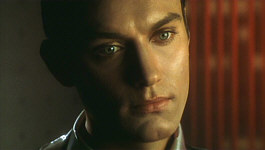 A.I. Artificial Intelligence appears in an aspect ratio of approximately 1.85:1 on this single-sided, dual-layered DVD; the image has been enhanced for 16X9 televisions. Overall, the picture looked quite good, but a few small concerns knocked it down to “B+” level.
A.I. Artificial Intelligence appears in an aspect ratio of approximately 1.85:1 on this single-sided, dual-layered DVD; the image has been enhanced for 16X9 televisions. Overall, the picture looked quite good, but a few small concerns knocked it down to “B+” level.
Sharpness seemed generally fine, though the film’s first act displayed some issues. That sequence looked a little soft and hazy at times. However, the rest of the movie appeared nicely well defined and distinct. Jagged edges and moiré effects created no concerns, and I also noticed no obvious signs of edge enhancement. Print flaws essentially seemed absent. I noticed a fair amount of grain during the first act, but a lot of that clearly emanated from the original photography. Significantly, the image cleaned up when Martin returned from the cryogenic freeze, so I felt Spielberg intentionally used the grain and semi-murkiness evident during the prior scenes.
Colors varied, also dependent on the setting. During the first act, the tones remained fairly muted and earthy, but they brightened after that, especially when Monica abandons David. The Flesh Fair and Rouge City displayed vivid and tight tones and looked quite vibrant. Overall, the colors seemed to accurately replicate the original material. Black levels came across as deep and dense, but shadow detail was more erratic. Again, the first act showed the most concerns, as low-light sequences were somewhat muddy. Still, I thought that the DVD accurately replicated the source footage well.
Even better, the Dolby Digital 5.1 and DTS 5.1 soundtracks of AI seemed very satisfying. For the most part, the pair appeared identical to me. I noticed the usual volume differences between the two, but qualitatively, they came across as very similar.
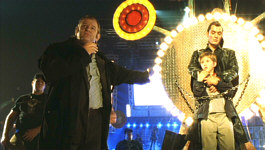 The soundfield started quite subdued while we spent most of our time at the Swinton home. Those sequences used the side and rear speakers mostly for general ambience. However, once David ventured out in the world, the track became significantly more active and involving. For the rest of the film, the audio seemed lively and engaging. Music showed good stereo imaging, and the effects melded together to create a nice sense of setting. Elements moved smoothly across the spectrum, especially when we heard vehicles in Rouge City and the Flesh Fair.
The soundfield started quite subdued while we spent most of our time at the Swinton home. Those sequences used the side and rear speakers mostly for general ambience. However, once David ventured out in the world, the track became significantly more active and involving. For the rest of the film, the audio seemed lively and engaging. Music showed good stereo imaging, and the effects melded together to create a nice sense of setting. Elements moved smoothly across the spectrum, especially when we heard vehicles in Rouge City and the Flesh Fair.
These sequences also brought the surrounds to life well. Motorcycles and helicopters zoomed around the back speakers neatly and made the mix come across as tight and distinctive. The Dr. Know sequence also added nice dimensionality to the movie.
Audio quality appeared solid. Speech sounded natural and distinct, and I noticed no issues related to intelligibility or edginess. Music seemed vivid and bright, and the score showed nice depth and warmth. Effects were consistently concise and accurate, and they also displayed excellent low-end material. Across the board, bass response appeared deep and taut. Overall, AI presented very positive sound.
This two-DVD release of AI packs a slew of extras, most of which reside on the second disc. On DVD One, we only find a featurette called Creating AI. This offers a general introduction to the package’s supplements. Here and on subsequent programs, we get a mix of movie clips, behind the scenes footage, and interviews. For “Creating”, we hear from executive producer Jan Harlan, director/writer Steven Spielberg, and producers Bonnie Curtis and Kathleen Kennedy. The show follows the film’s early development and the collaboration between Spielberg and Kubrick, and we learn why Spielberg decided to write the movie himself. “Creating” provides a fairly loose preface to DVD Two’s supplements; it sets the stage but doesn’t offer anything much that you won’t find repeated on the second disc.
 When we move to DVD Two, we find most of the components. In the domain called “Acting AI”, we get two featurettes. A Portrait of David runs for nine minutes and six seconds as it covers Haley Joel Osment and his character. We get comments from Spielberg plus actors Osment, Sam Robards, Frances O’Connor and Jude Law. The show covers the need to use a human actor instead of a CG creation as well as development of the character, practical elements like make-up, and working with props and sets. Despite too many movie clips, “David” offers a nice look at the subject. The behind the scenes shots seem solid, and Osment offers good perspective about his work. The others devote too much time to simple praise of the young actor, but “David” still provides a decent piece.
When we move to DVD Two, we find most of the components. In the domain called “Acting AI”, we get two featurettes. A Portrait of David runs for nine minutes and six seconds as it covers Haley Joel Osment and his character. We get comments from Spielberg plus actors Osment, Sam Robards, Frances O’Connor and Jude Law. The show covers the need to use a human actor instead of a CG creation as well as development of the character, practical elements like make-up, and working with props and sets. Despite too many movie clips, “David” offers a nice look at the subject. The behind the scenes shots seem solid, and Osment offers good perspective about his work. The others devote too much time to simple praise of the young actor, but “David” still provides a decent piece.
Even better, A Portrait of Gigolo Joe runs six minutes and examines the other main Mecha. We get information from Spielberg and Law only. They discuss character development and how Kubrick’s original notes influenced Joe. Law tells us how he became involved in the film and we also get notes about his approach to the role. Short but tight, “Joe” offers a nice examination of the actor’s work.
Called “Designing AI”, the next section starts with A.I.: From Drawings to Sets. It lasts seven minutes and 26 seconds and includes remarks from concept illustrator Chris Baker and production designer Rick Carter. It goes over Baker’s involvement and his designs as well as the realization of the visuals. We also get a look at the sets and hear about the lack of locations. The behind the scenes images seem good, but “Sets” doesn’t give us much concrete information beyond that.
Up next, Dressing A.I. runs five minutes, 28 seconds and involves costume designer Bob Ringwood. He goes over his general approach to the movie’s clothes and costumes as well as specifics for Monica, David and Gigolo Joe. Fairly concise and informative, “Dressing” offers a nice look at the subject.
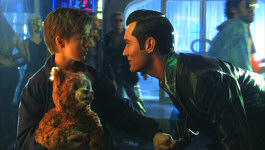 For Lighting A.I., we get comments from director of photography Janusz Kaminski. In the four-minute and 23-second program, he discusses the different styles used in the movie as well as other general comments about his work. Kaminski offers a little insight into the process but doesn’t give us much depth.
For Lighting A.I., we get comments from director of photography Janusz Kaminski. In the four-minute and 23-second program, he discusses the different styles used in the movie as well as other general comments about his work. Kaminski offers a little insight into the process but doesn’t give us much depth.
Next we find Special Effects, a seven-minute and 44-second discussion with special effects supervisor Michael Lantieri. He chats about working with Spielberg in general as well as specifics about the Flesh Fair robot cannonball, the Rouge City helicopter, and the ice-covered Blue Fairy. The footage from the set remains good, and the emphasis on the practical effects offers a good look at the topic in this tight and informative special.
In Robots of A.I., we hear from Spielberg, special robotic effects creator Stan Winston, voice actor Jack Angel, Stan Winston Studio effects supervisors J. Alan Scott and Lindsay McGowan, and key make-up artist Ve Neill. The 13-minute and 41-second piece includes a general discussion of the film’s robots plus some notes about Gigolo Joe’s make-up and the methods used to bring Teddy to life. The latter subject occupies most of the program, as we get specifics about Teddy. Overall, the chat seems like a useful examination of the topic.
The next major domain is called “Special Visual Effects and Animation: ILM” and it splits into five featurettes. An Overview runs five minutes and 10 seconds as it presents comments from visual effects supervisor Dennis Muren. It covers Muren’s early meeting with Kubrick plus preliminary thoughts for the flick. Mostly Muren provides basic comments about elements like a previsualization system used on the set. Again, the behind the scenes material seems good, but
The Robots runs three minutes and 23 seconds and includes remarks from ILM visual effects supervisor Scott Farrar. He covers the visual effects used for the robots and puts an emphasis on the robot secretary. Despite its brevity, “Robots” gives us a decent little chat, and it seems especially useful when we see a demonstration of the robot secretary.
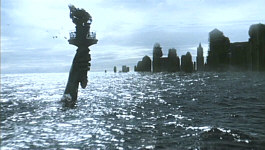 For The Miniatures, we hear from Farrar, ILM visual effects art director David Nakabayashi, ILM model supervisor Steve Gawley, and ILM visual effects producer Ginger Theisen. In the four-minute and 16-second piece, we learn about the development of different sets and their miniatures, “dry for wet” photography, and the development of both Coney Island and Rouge City. Another useful and informative piece, this one goes over its topics well.
For The Miniatures, we hear from Farrar, ILM visual effects art director David Nakabayashi, ILM model supervisor Steve Gawley, and ILM visual effects producer Ginger Theisen. In the four-minute and 16-second piece, we learn about the development of different sets and their miniatures, “dry for wet” photography, and the development of both Coney Island and Rouge City. Another useful and informative piece, this one goes over its topics well.
A more specific program, The New York City Sequence: Shot Progression lasts two minutes and 51 seconds. It includes comments from ILM associate visual effects supervisor Doug Smythe. He offers a decent look at the different elements that create this scene.
The final ILM featurette, Animating A.I. runs eight minutes, six seconds and provides remarks from ILM animation supervisor Hal Hickel and ILM computer graphics sequence supervisor Christopher Townsend. It covers animated shots of Teddy, Dr. Know, some robots, and the Blue Fairy. Another informative and entertaining examination, it gives us a tight look at the subjects.
The next section, “The Sound and Music of A.I.” splits into two domains. Sound Design takes six minutes, 45 seconds and features statements from sound designer Gary Rydstrom. He discusses his early involvement in film as well as the three sections of the movie, each with their own feeling. Not a great piece, Rydstrom adds a few nice notes but the show remains somewhat superficial.
In The Music, we hear solely from composer John Williams. The five-minute and 49-second program goes over Kubrick’s insistence that a certain Strauss piece appear in the film plus general notes about other elements. Williams offers a decent chat about different tones and pieces but “Music” doesn’t seem like anything special.
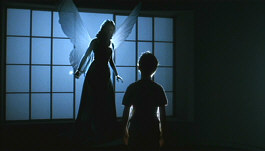 Called Closing: Steven Spielberg: Our Responsibility to Artificial Intelligence, the final featurette lasts two minutes, 26 seconds and only features Spielberg. A cautionary message, it doesn’t seem very informative or interesting. The short piece also includes the DVD’s credits.
Called Closing: Steven Spielberg: Our Responsibility to Artificial Intelligence, the final featurette lasts two minutes, 26 seconds and only features Spielberg. A cautionary message, it doesn’t seem very informative or interesting. The short piece also includes the DVD’s credits.
After this we move to the “A.I. Archives”, an area that divides into more subdomains. We get two trailers, both presented non-anamorphic 1.85:1 with Dolby Digital 5.1 audio. Storyboards gives us images of “Joe’s Goodbye” (35 stills), “David’s Leap” (37 shots), and “David and the Blue Fairy” (27 frames).
More stillframe art appears in Chris Baker’s Portfolio. This splits his drawings into seven different areas and includes 63 pieces of art in all. The Production Design Portfolio breaks into nine sections of drawings and gives us 52 total. Lastly, the ILM Portfolio divides into six areas with a total of 53 images.
Next we get photographs. Portrait Gallery Photographs by David James gives us 29 shots, while Steven Spielberg Behind the Scenes Photographs by David James includes 71 pictures. The “Portrait Gallery” seems dull, but the “BTS” stuff offers some fun shots.
Text shows up next. Cast includes biographies of Haley Joel Osment, Jude Law, Frances O’Connor, Sam Robards, Jake Thomas, Brendan Gleeson, William Hurt, and Jack Angel. Filmmakers provides listings for director/writer/producer Steven Spielberg, producers Kathleen Kennedy and Bonnie Curtis, executive producers Walter F. Parkes and Jan Harlan, editor Michael Kahn, cinematographer Janusz Kaminski, composer John Williams, production designer Rick Carter, costume designer Bob Ringwood, special robotic effects Stan Winston, and special effects supervisor Michael Lantieri. Essentially all of these feature annotated filmographies, as they lacked detailed information about the participants.
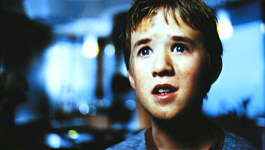 In contrast, the Production Notes seem quite extensive and detailed. This section includes very nice comments about many elements of the film. It provides a satisfying extra.
In contrast, the Production Notes seem quite extensive and detailed. This section includes very nice comments about many elements of the film. It provides a satisfying extra.
An erratic film, A.I. Artificial Intelligence boasts excellent visual design and some intriguing elements. However, the movie runs way too long and suffers from a few too many flaws to become anything more than only sporadically satisfying. The DVD presents consistently solid picture and sound as well as a fairly nice collection of extras. Enough of AI works well for me to at least recommend it as a rental for those who’ve not already seen it. Fans of the film should definitely like this fine DVD presentation, though, so for them I whole-heartedly advise a purchase.

